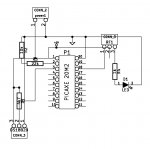Hello all,
this is my first post here, I only started with picaxe and electronics a couple of months ago.
I'd like to ask how is it with powering these rf modules. I saw recommendations only to power the module when actually transmitting (using a transistor), so that it won't flood the "ether". But when I measure the current flowing through the transmitter, it's practically zero when it's not transmitting (no data being sent to it), so I'm wondering... Do any of the members here have experience with these modules and could enlighten me in this matter?
Thanks in advance!
this is my first post here, I only started with picaxe and electronics a couple of months ago.
I'd like to ask how is it with powering these rf modules. I saw recommendations only to power the module when actually transmitting (using a transistor), so that it won't flood the "ether". But when I measure the current flowing through the transmitter, it's practically zero when it's not transmitting (no data being sent to it), so I'm wondering... Do any of the members here have experience with these modules and could enlighten me in this matter?
Thanks in advance!

